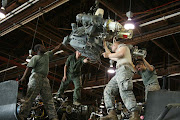Over the years nuclear power has been used in other countries, for example France gets 78% of its electricity from nuclear power plants (Petit). As of right now 85% of the United States electricity comes from fossil fuels: coal, oil, and natural gas (U.S.DOE). Fossil fuels take millions of years to form and from relying on fossil fuels for such a long time, the source is starting to run out, and not only are they running out, the fuels are emitting greenhouse gases into the air. With all the issues that go along with fossil fuel power plants , nuclear power plants are starting be a alternative for power in the United States. Nuclear power plants give off no green house gases, which is a major focus to drastically reduce emissions of green house gases, and in the long run cost less for the consumer. But nuclear power plants are extremely expensive to build, costing anywhere from $5 billion to $12 billion (Richard).
Nuclear power gives off less waste than that of fossil fuels, but the radio-active waste has to be properly stored long-term. Although there is less radio-active waste it stays active for thousands of years meaning that it has to be carefully watched. there is nuclear waste repositories that hold the waste safely underground in enclosed areas. There are two types of waste: low level waste, and high level waste. Low level waste is objects that have been contaminated with radioactive materials, while high level waste are highly radioactive materials that are byproducts of reactions that take place in nuclear power. Both of these radioactive waste have designated disposal areas in the United States. Low level waste is sent to Richland, Washington; Barnwell, South Carolina; and Clive, Utah. High level waste is sent to Yucca Mountain, Nevada. High level waste can have up to a 24,000 year half-life, meaning that it will still be radioactive while it is in the disposal area. Because the radioactive waste does have a half-life precautious measures must be put in place to prevent any accidents from happening. Yucca Mountain holds nuclear fuel rods, and solidified high-level radioactive waste, that is put in underground tunnels. Their is always the possibility of a failed disposal which would contaminate the area and could contaminate ground water, which will affect the population in the area.
After the attack of 9/11 it has been more worrisome that nuclear power plants will be more vulnerable to terrorist attacks. A terrorist with large explosives has a very good chance to damage a nuclear power plant, which would lead to thousands of people to have radiation exposure, the exposure leads to cancer and death. In the event of a nuclear reactor meltdown the impact could have no affect or have a huge affect on the people in the range of the explosion. To prevent a reactor meltdown the power plant must be safely designed to the core cooled if there is any loss of coolant. On March 28th, 1979 the Three Mile Island Unit 2 nuclear power plant outside of Middletown, Pennsylvania had a incident, when a feed water pump stopped working, the pump allowed the steam generators remove heat from the core; after that happened the reactor shut down creating pressure, leading to much pressure that caused the core of the reactor to overheat. The coolant for the reactor gave confusing readings to the reactor operators. This event gave off radiation, but luckily it just gave off a low amount of radiation that was enough not affect the people in the town. This accident brought attention to what can happen if a accident happens at a nuclear power plant, American citizens had a sense of uneasiness, and led to higher regulations. More recently was the Chernobyl Nuclear Power Plant reactor accident in Ukraine on April 26th, 1986 a reactor became unstable and caused a steam explosion; the core was exposed and large amounts of radiation were emitted in the area. The radiation was at lethal levels, millions of people were contaminated, and the surrounding areas were evacuated. Before any nuclear power plants are built today they must undergo excessive planning and must undergo regulations by the United States Nuclear Regulatory Commission, which was created by congress in 1974 to ensure that people and the environment are protected from radioactive material. The U.S.NRC inspects and reviews performances of all nuclear power plants in the United States; their goals are to have no nuclear reactor accidents, no deaths resulting from acute radiation exposure from nuclear reactors, no events at nuclear reactors resulting in significant radiation exposure, no radiological sabotages at nuclear reactors, and no events that result in releases of radioactive material from nuclear reactors causing adverse impact on the environment5. Although this organization was put in place there is still that dangers of nuclear power plant disasters that could be catastrophic.
Nuclear power plants are a logical alternative for power. But their seems to be no completely safe way to build a nuclear power plant. By putting a nuclear power plant near a town puts the civilians at risk, which a coal power plant would not do. The economy today could not risk spending billions of dollars on building a nuclear power plant, this would cost the government billions of dollars that the tax payers could not afford. With the fear of terrorism attacks and nuclear reactor meltdowns American citizens are not ready to depend on nuclear power plants to receive their power.
Works Cited
Talbot, David. “Nuclear Powers Up.” Technology Review Vol. 108 Issue 9
(September 2005)
Garber, Kent. “A Tough Nuclear Decision.” U.S. News and World Report. Vol. 145 Issue 10
(November 2008):44-45
http://search.ebscohost.com/login.aspx?direct=true&db=aph&AN=34982462&site=ehost-live
(April 2006):984-986
Grunwald, Michael. “Going Nuclear.” Time Magazine Vol. 173 Issue 1.
(January 2009): 38-39
http://search.ebscohost.com/login.aspx?direct=true&db=aph&AN=35921057&site=ehost-live
(Summer 2008): 238-246
http://search.ebscohost.com/login.aspx?direct=true&db=aph&AN=35045211&site=ehost-live
Klein, Andy., and Jack Lance. “Future Directions, Challenges And Opportunities In Nuclear Energy.”
AIP Conference Proceedings Vol. 894 Issue 1
(2007): 32-36
http://search.ebscohost.com/login.aspx?direct=true&db=aph&AN=24505401&site=ehost-live
Lyman, Edwin. “Can nuclear plants be safer?” Bulletin of the Atomic Scientists Vol. 64 Issue 4
(October 2008): 34-37
http://search.ebscohost.com/login.aspx?direct=true&db=aph&AN=34043151&site=ehost-live
(January 2009): 6-7
http://search.ebscohost.com/login.aspx?direct=true&db=aph&AN=36262177&site=ehost-live
(January 2004): 433-433
http://search.ebscohost.com/login.aspx?direct=true&db=aph&AN=12186409&site=ehost-live
(April/May 2004):8-8
http://search.ebscohost.com/login.aspx?direct=true&db=aph&AN=13269671&site=ehost-live
Rosner, Robert. “Making nuclear energy work.” Bulletin of the Atomic Scientist. Vol. 64 Issue 1
(March/April 2008): 28-57
http://search.ebscohost.com/login.aspx?direct=true&db=aph&AN=32587048&site=ehost-live
Sharder-Frechette, Kristin. “Five Myths About Nuclear Energy.” America Vol. 198 Issue 20.
(June 2008): 12-16
http://search.ebscohost.com/login.aspx?direct=true&db=aph&AN=32625382&site=ehost-live
(September/October 2008): 15-18
http://search.ebscohost.com/login.aspx?direct=true&db=aph&AN=34319492&site=ehost-live
Wicks, Frank. “50 Years of Nuclear Power.” Mechanical Engineering Vol. 129 Issue 11
(November 2007):36-39
http://search.ebscohost.com/login.aspx?direct=true&db=aph&AN=27459914&site=ehost-live
“Nuclear Power vs. Other Technologies.” Georgia Power 2009
Petit, Charles. “Nuclear Power.” National Geographic. April 2006.
“Fossil Fuels.” U.S. Department of Energy. 10 Apr. 2008








No comments:
Post a Comment